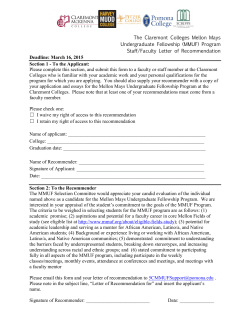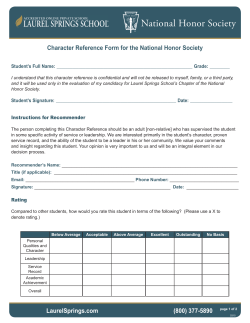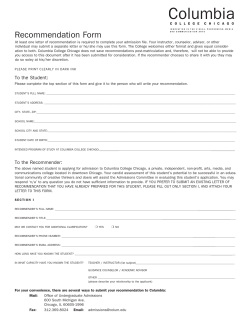
Content Based Recommender System for Map Routing
Content Based Recommender System for Map Routing Gurbinder Kaur Department of Computer Science and engineering Chandigarh University, Mohali, Punjab, India Vijay Kumar Department of Computer Science and engineering Chandigarh University, Mohali, Punjab, India Amritpal Singh Department of Computer Science and engineering Thapar University, Patiala, Punjab, India Abstract- In the past few years, with the proliferation of mobile devices people are experiencing frequent communication and information exchange. For instance, in the context of people’s visits, it is often the case that each person carries out a smart phone, to get information about nearby places. When one visits some location, an application will recommend useful information according to its current location, preferences and past visits. In this paper we address the key features and development of a map routing application. This application is based on content filtering. The basic purpose of this application is to provide an accurate recommendations for hospitals, ATMs etc according to users likings in map route by using (Content Based Recommender System) CBR_System. This approach has its roots in information filtering and retrieval research. The proposed system has also taken care of the cold start problem for new users. Keywords -Recommender System, Content Filtering I. INTRODUCTION When an individual travels to a new city for vacation or business or is simply relocating to a fresh setting, the person needs a method to receive information on the routes to utilize and sites to see. Asking a local dweller can yield good recommendations for destinations: from parks to restaurants to museum to trails. Visiting for any travel websites or from books or brochures can also encourage ideas of sites to visit in a new place [2]. In today’s world tourists have also many options with their mobile devices to receive recommendations about a city’s attraction and sites as well as to navigate the routes to find the location of their interest. Tools like Bing Maps and Google Maps have robust systems to recommend routes between locations as well as information about those places. While these applications provide a necessary tool for the unknowing traveller and have polished and intuitive interfaces, there are still elements that are missing from these systems. The purpose of this paper was to build an application for mobile devices that combines Google Maps with the idea of recommending parameters like food, hospitals, ATMs etc according to users’ current location, preferences and past visits by using content filtering approach We address the development and the key features of a map routing with a mobile application which is based on content filtering. In CBR_System recommendations are provided on the basis of user profile, description of items and keywords are used to describe the items in content based recommender systems. Set of terms describes the content of each item, usually the words that occur in the document. Recommendations are provided to the users according to their likings (when user profile matches with the same terms).The architecture of CBR_System is shown below: Profile learner Represente d items Content Analyzer Source of information new item Profile Filtering component Feedback Active User List of recommend ations Fig 1: Architecture of CBR_System [1] First step of CBR_System is to represent the content of items which is the responsibility of the component when information has no structure (e.g. documents, news, webpages etc). Item descriptions coming from information source are processed by the content analyzer, which extracts features from unstructured text to produce a structured item representation, stored in the represented items (repository).Second step is to construct and update the profile of the active user by collecting users’ reactions to items in some way and record them into the repository feedback. These reactions together with the description of related items are exploited during the process of learning a model useful to predict the actual relevance of newly presented items. In third step, profile learner applies supervised learning algorithm to generate a predictive model-the user profile which is usually stored in a profile repository for later by the filtering component. Filtering component predicts items that whether it is likely to be of interest for the active user by comparing features in the item representations to those items stored in the user profile and then recommend items to the users. The basic purpose of this application is to provide the accurate recommendations for the parameters like hospitals, ATMs, food etc in map routing by using CBR_System in which previously selected item by user is shown in application and further recommendations are provided to user according to their interest. The system suggests routes based on both the user’s past actions and its current location. The proposed system also provides solution to the cold start problem for the new items. Cold start problem is very common in recommender systems. Cold start problem occur when new user is added and system do not know what to recommend to that new user. The proposed system also has taken care of this problem. The remainder of this paper is organized as follows. Section II briefly reviews the related work of CBR_System and work done in this field. Section III provides methodology used by us to recommend the routes in the map along with the accurate results according to the selected parameters. Section IV provides discussion and future work. Finally, Section V ends the paper with some conclusion remarks. II. RELATED WORK In this Section, we briefly review the key features of existing map routing applications, proposed in the past few years. The TouristEye service [9, 10] is available as a Web application, with mobile clients for iPhone and Android. It offers a wide range of points of interest organized by categories such as attractions, entertainment and restaurants. Registered users can mark touristic places as visited, provide a comment stating their degree of satisfaction, and they can describe their visits, by taking notes and photos in the mobile application. Users can plan their trips, composed by points of interest, and the map service is used to display routes between these locations. This service has an integrated recommender system such that new points of interest are automatically displayed to the user. Bradley Hayden Bahls [2] proposed the recommender system to build an application for a mobile device that combines Google Maps with the idea of recommending routes that are beautiful, user-targeted, and safe in an unfamiliar city. This application gives path recommendations based upon not only the destinations, but also the route itself. Users can utilize this system to explore new areas of cities and offer feedback to build routes to their needs. Artem Umanets et al. [3] proposed a Guide me application who will recommend useful information to the user according to their current location, preferences and past visits. It’s a mobile and web application provides consultation, publication and recommendation of touristic locations. Each user may consult places of touristic interest; receive suggestions of previously unseen touristic places according to other users’ recommendations, and to perform its own recommendations. Peter Aksenov et al. [4] proposed the concept of “smart routing”-a personalised recommender system for cultural tourism that takes into account the varying nature of tourists’ dynamic needs and preferences. Three level of activity specification are considered in this.1) a program level, i.e. selecting a set of relevant points of interests (POIs) to be included into the tour, 2) a schedule level, i.e. arranging the selected POIs into a sequence, 3) a travel route level, i.e. determining a set of multimodal trips to be made between the POIs included in the tour. The GuidePal Offline City Guides [11] allows for users to download varied content for different cities and to consult information regarding coffee shops, restaurants and other attractions. In order to list the existing points of interest, the user selects the desired city and category. Afterwards, a description for the points of interest is shown. The mTrip travel guide service [12] is mainly used for big cities such as Berlin and Paris, among others. It is available as a separate application for each one of the major cities and allows people to consult information regarding points of interest without an Internet connection. Users can schedule or create guides for the cities by providing the detailed information on the touristic attractions which they plan to visit. Each point of interest is accompanied by a description, a photo, opening hours, prices, as well as the comments and ratings from other travellers. It includes augmented reality tool to preview the points of interest near the user’s location. The Triposo service [13] offers similar features to those of mTrip. However, it includes much more countries as well as smaller cities. When one picks the country to visit, the download of information regarding the points of interest for that country starts immediately, allowing to consult this information later in offline mode. For big cities, it provides special information regarding the city guide about all sighs, a list of restaurants and extended nightlife options. It also provides a travel dashboard with currency converter, weather info, and useful native language phrases. Foursquare [14] is a service that allows registered users to “check-in” at their current location. It provides Web and mobile applications for iPhone, Android and Blackberry. Users with special permission can contribute with new locations, such as coffee shops, sights and restaurants. The service was created in 2009, in March 2011 a recommender system was added for suggesting places that user might like, based on their past actions. In 2013, a new version was published allowing users to consult the sights nearby their current location. After reviewing the current research on the use of map routing we concluded that sometimes recommendations are not relevant in our daily life only pre analysis is performed for recommendations and also the data retrieval is not fast. We are proposing a content based recommender system for map routing which provide more relevant recommendations and also fast retrieval of data base. The adoption of content based filtering has some advantages i.e. user independence, tranparency and it also overcomes the cold start problem. [1] III. PROPOSED WORK This paper proposed the CBR_System for map routing based on content filtering in which we tried to build an application which provides accurate recommendations to user according to their needs. A. Problem Formulation Content based recommender systems recommend items that are similar to those that a user liked in the past. In particular, various candidate items are compared with items previously rated by the user and the best-matching items are recommended [1]. We use CBR_System to provide accurate recommendations for parameters like hospitals, ATMs, food etc in map routing according to users preferences, past visits and current locations by using content filtering approach. B. Proposed content Approach The proposed system is map routing application based on content based recommender system for better recommendations. Fig 2: Describes the process of CBR_System. New user Store user information Parse the data from GooglePlaces API Fetch the map data from the database Analyze the collected information Map route recommender Fig 2: Flow chart of proposed technique The various phases of the proposed approach are described below. 1) New user: For the new user, the system requests to register him/her for an account to gather his preferences. 2) Map database: Collect the information for recommendations in map such as routes, shortest path, parameters like hospitals, restaurants, doctor, cafe etc. 3) Information collected: Analyze the collected information by filtering component that whether it is likely to be of interest to the active user by comparing features in the item representations to those items stored in the user profile. 4) Map route recommender: This phase recommend routes to the user and use following steps User Record Fetch user’s data and map route recommendations No Last record Yes Find route which contains max. no. of selected parameters Generate routes recommendations for Fig 3: Flow chart for map route recommendations IV. DISCUSSION AND FUTURE WORK To find out related content is very difficult task in current scenario where there are huge amount of data is stored in the databases. Recommender systems are solution to this problem and attracting researchers to explore this area in past few years. This paper also tries to solve the problem for recommending routes in map. In this paper we propose an application which recommend accurate route to the user according to their needs. Wrong recommendations assigned to the user tend to decrease the efficiency of the system but this problem is reduced by using CBR_System and optimal recommendations are provided to the user. This paper also have taken care of the cold start problem for new items where we do not know how to recommend that new item or what to recommend to that new user added to the system. Overview of this system has shown below: Table1: Overview of the content based approach Approach Content Item data Keywords/ Descriptio n User data Profile of items the user has liked Recommend Item with most similar description to one of the items in the user’s profile Pros -domain independent -transparency -new item cons -manual entering description -depends upon quality of description -gray sheep -stability vs. plasticity This system can be further improved by combining collaborative and content filtering techniques to provide accurate recommendations on the basis of ratings. V. CONCLUSION This paper proposed the system to recommend items to users that are similar to those that a user liked in the past. The application gives path recommendations based on parameters selected by user. This approach has its root in information retrieval and information filtering research. The system is functional as well as user-friendly. The simplicity of the design prevents any confusion. Layouts and menu are fluid and easy to use. The system becomes self-learning as more people use the system and gives their knowledge to the system and ultimately its capability to return related research parameters helps to solve users’ problems. REFERENCES [1] [2] [3] [4] [5] [6] [7] [8] [9] [10] [11] [12] [13] [14] [15] [16] F Ricci, L Rokach, B Shapira, “Introduction to recommender systems handbook.” Springer US, 2011. Bahls, BradleyH, “Pedestrian Pal: A Route Recommendation System for the Android Mobile Phone” Theses, Dissertations, Professional Paper, Paper737. 2011. Artem Umanets “GuideMe-A tourist Guide with a Recommender System and Social Interaction” Conference on Electronics, Telecommunications and Computers-CETC, ELSVIER (407-414) 2014. Peter Aksenov, Astrid Kemperman and Theo Arentze., “Toward personalised and dynamic cultural routing: a three-level approach” 12th International Conference on Design and Decision Support Systems in Architecture and Urban Planning, DDS, ELSVIER (257269) 2014. Content Based Recommender System entry in Wikipedia: http://en.wikipedia.org/wiki/Content Based RS. Yansen Wang, “Google Map Integration”, Science Direct 2013. J.Delgado, “Content-based collaborative information filtering: actively learning to classify and recommend documents,”IEEE1999. N.J.Belkin and W.B. Croft, “Filtering and information retrieval: two sides of the same coin,”IEEE 1992. J.Escribano and A.Camus.La guia de viajes inteligente que aprende de ti y tus amigos, November2012.www.slideshare.net/betabeers/touristeye Tourist Eye, Inc, www.touristeye.com.TouristEye Web Application, 2012. GuidePal, Inc, guidepal.com.GuidePal Home, 2012 mTrip, Inc, www.mTrip-Intelligent Travel Guides, 2011. Triposo, Inc, www.triposo.com.Triposo Travel Guides, 2012 Foursquare, Inc, foursquare.com.Building a recommendation engine, Foursquare style, March 2011 G.Linden, B.Smith and J.York, Amazon.com Recommendations, Industry Report: IEEE Internet Computing, 2003 p.76-80 A.Almeida, B.Coelho, and C.Martins.Intelligent hybrid architecture for tourism services. In max Bramer, editor, IFIP AI, volume 331 of Advances in Information and Communication Technology, pages 205-214.Springer, 2010.
© Copyright 2025










